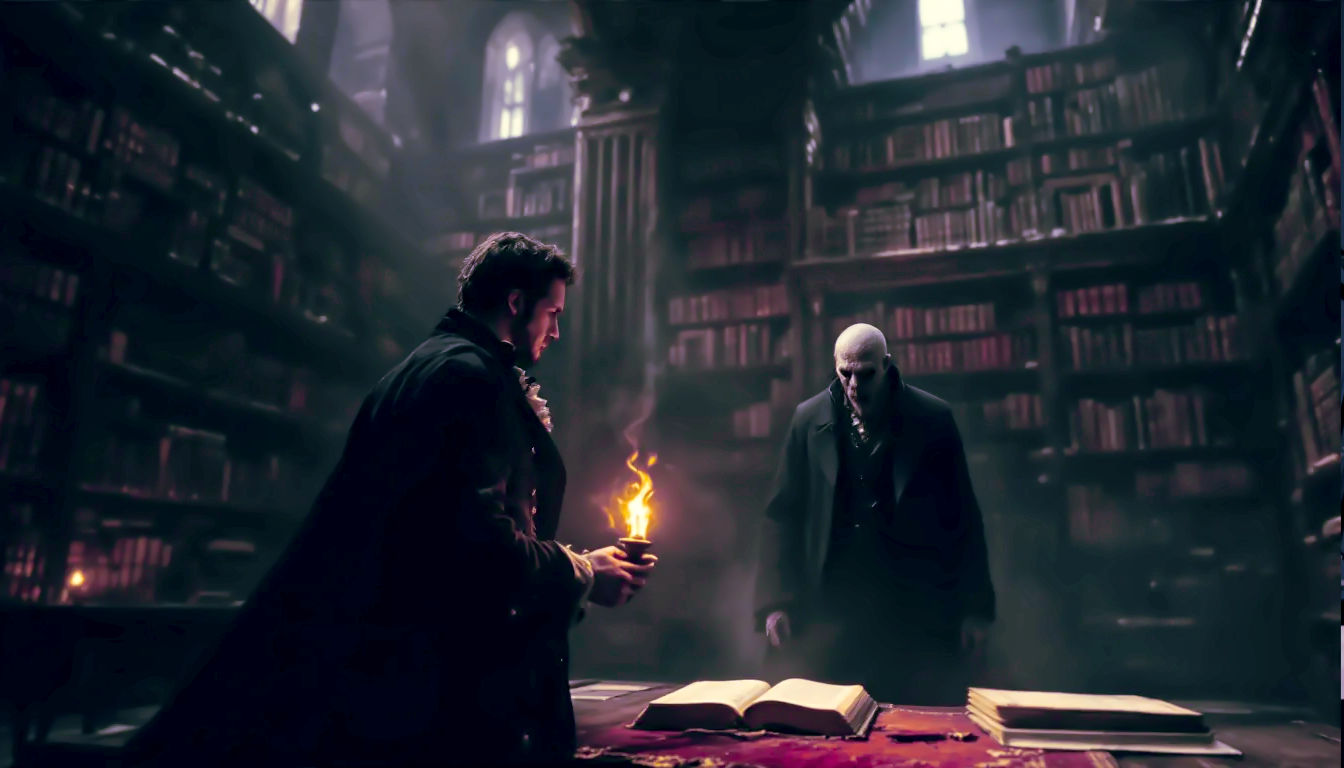The Guide to H.P. Lovecraft’s The Alchemist: A Tale of Curses, Revenge, and Cosmic Dread’s First Whisper
A complete guide to H.P. Lovecraft’s The Alchemist, exploring the story’s ancient curse, its shocking twist, and how it shaped a master of horror.

This post may contain affiliate links. If you make a purchase through these links, we may earn a commission at no additional cost to you.
Picture a crumbling castle, somewhere in the heart of old France. Rain lashes against the stained-glass windows, and inside, a lone figure pores over ancient books by candlelight. He is the last of his line, haunted by a centuries-old curse that promises a grim, early death. This isn’t just the start of any old ghost story; it’s the opening scene of “The Alchemist,” one of the very first tales written by a young man who would go on to change horror forever: H.P. Lovecraft.
Before the cosmic tentacles of Cthulhu, before the mind-bending horrors from beyond the stars, there was this simple, chilling tale of Gothic revenge. Written when he was just a teenager, “The Alchemist” is a fascinating peek into the mind of a master in the making. It’s a story that wears its influences on its sleeve, drawing heavily from the dark, brooding tales of Edgar Allan Poe, but it also contains the first tiny seeds of the themes that would define Lovecraft’s work.
So, let’s pull back the dusty velvet curtain on this often-overlooked gem. We’ll walk the haunted corridors of the de C— family, uncover the secrets of the curse that plagued them, and meet the mysterious alchemist at the heart of it all. This is the complete guide to understanding “The Alchemist”—a story of vengeance so powerful it refused to die.
Who Exactly Was H.P. Lovecraft?
Before we dive into the story, it helps to know a bit about the fellow who wrote it. Howard Phillips Lovecraft, born in 1890 in Providence, Rhode Island, wasn’t your typical author. A reclusive and eccentric figure, he was a man out of time, fascinated by the 18th century and utterly terrified of the modern world.
He was a prodigy, reading by the age of three and writing poems by six. But his childhood was marked by tragedy and illness. His father was committed to a psychiatric hospital when Lovecraft was young, and his mother was deeply overprotective. This isolated upbringing fuelled his imagination, leading him to create worlds filled with ancient gods, forbidden knowledge, and the chilling idea that humanity is just a tiny, insignificant speck in a vast, uncaring universe.
When he wrote “The Alchemist” in 1908, he was only 17. At this stage, he wasn’t the master of “Cosmic Horror” he’d become. He was a young writer honing his craft by imitating his hero, Edgar Allan Poe. This story, therefore, is less about alien gods and more about classic Gothic chills: family curses, crumbling castles, and dark secrets best left undisturbed. It’s a crucial stepping stone that shows us where he came from before he journeyed into the cosmos.
The Story’s Origins: A Teenager’s Gothic Dream
Lovecraft penned “The Alchemist” when he was just a teenager, and you can really feel that youthful energy and passion for the Gothic. It was eventually published in 1916 in a small amateur magazine called The United Amateur. It wasn’t a professional sale, but it was a start.
The biggest influence on the story is, without a doubt, Edgar Allan Poe. Think of Poe’s classics like “The Fall of the House of Usher,” with its decaying mansion and doomed family line. Lovecraft takes that blueprint and runs with it. The atmosphere, the first-person narrator descending into obsession, the theme of a cursed bloodline—it’s all pure Poe.
But “The Alchemist” is more than just a copy. It’s Lovecraft taking those familiar ingredients and adding his own unique flavour. He was fascinated by history, science, and the idea of hidden knowledge. The story’s focus on alchemy—a kind of mystical medieval chemistry—and the search for the elixir of life is a classic Lovecraftian touch. He loved the idea of someone digging too deep into secrets man was not meant to know, a theme that would later explode into full-blown cosmic terror in his famous Cthulhu Mythos stories.
A Walk Through the Shadows: The Plot of The Alchemist
The best way to understand the story is to walk through it step by step. It’s a short, sharp shock of a tale, building suspense beautifully towards a knockout twist.
The Curse is Cast
Our story begins with our narrator, Count Antoine de C—, a lonely, scholarly man who is the last of his noble family. He explains that his line is cursed. For centuries, no male heir has lived past the age of 32. This isn’t just bad luck; it’s the result of a dreadful event that happened way back in the 13th century.
His ancestor, Godfrey de C—, was a medieval nobleman who discovered that his castle was shared by a mysterious old man named Michel Mauvais. Michel was an alchemist, rumoured to have discovered the Elixir of Life—a potion that grants immortality. Godfrey, being a suspicious and cruel man, accused Michel of murdering his own son, Henri, and had him killed.
As Michel was dying, his son, Charles le Sorcier (Charles the Sorcerer), arrived. Charles was an even more powerful alchemist than his father. Finding his father dead, he cursed Godfrey and all his descendants. He threw a vial of poison at Godfrey, killing him instantly, and declared that no male heir of the de C— family would ever live longer than the man they had murdered. Since Godfrey was 32, that became the doomed age for every man in the family.
Centuries of Dread
From that day on, the curse held true. Generation after generation, the Counts of C— died mysteriously just as they reached their 32nd birthday. The family grew smaller and poorer, their grand castle falling into ruin around them. The story becomes a grim catalogue of these deaths, creating a powerful sense of inescapable fate.
The locals, understandably, became terrified of the castle and the cursed family. They whispered tales of ghosts and demons haunting the ancient halls. This isolation only made things worse for the family, trapping them in their gloomy home with nothing but their books and their impending doom for company. It’s a classic Gothic setup: the decaying family trapped in a decaying house, waiting for a fate they cannot avoid.
Antoine’s Lonely Vigil
We then jump forward to the present day of the story, around the late 19th century. Our narrator, Antoine, is now approaching his own 32nd birthday. He’s lived his whole life in the shadow of the curse. He was raised by an old servant, Pierre, who tried to protect him from the terrible truth, but Antoine eventually found his family’s secret history in the castle library.
Instead of running away, Antoine dedicates his life to study. He becomes a recluse, just like his ancestors, shutting himself away in the castle. He reads everything he can about alchemy, black magic, and the occult, desperately searching for a way to break the curse. He is a man driven by a single, terrifying deadline. As his birthday gets closer, his search becomes more and more frantic.
The Hidden Chamber
One day, Antoine discovers a hidden passage in a remote, abandoned part of the castle. He’s both terrified and excited. Could this be where Charles le Sorcier performed his dark magic? He follows the passage down into the depths of the castle, eventually coming to a locked door.
After breaking it down, he finds a hidden chamber. It’s a laboratory, filled with the strange equipment of an alchemist. But it’s not ancient and dusty. It looks as if it’s still in use. On a table, he finds a manuscript written in Latin. As he reads it, he uncovers the incredible truth: Michel Mauvais had indeed discovered the Elixir of Life, and his son Charles had successfully created it. Charles had used it to achieve immortality, all so he could personally carry out his curse on every generation of the de C— family.
The Final Confrontation and the Twist
Suddenly, a trapdoor in the ceiling opens, and a figure descends into the room. It’s a man with a “face of startling intelligence and profound age.” He sees Antoine reading the manuscript and becomes furious, attacking him.
Antoine, fighting for his life, grabs a vial from the table—the very same one Charles had used to kill his ancestor Godfrey—and throws it at the old man. The man screams in agony as the poison works its magic, and just before he dies, he reveals the story’s brilliant, chilling twist.
He confesses that he is Charles le Sorcier himself. He has been living in the hidden parts of the castle for 600 years, personally murdering each heir as they turned 32, all to satisfy his unending thirst for revenge. With his death, the curse is finally broken. Antoine is free.
The Characters: A Doomed Count and an Immortal Avenger
The story really revolves around two key figures, whose fates are locked together across centuries.
Count Antoine: The Doomed Protagonist
Antoine is a classic Gothic hero. He’s sensitive, intelligent, and utterly trapped by his heritage. He’s not a man of action; he’s a scholar. His weapon against the curse isn’t a sword, but knowledge. He spends his life buried in books, trying to think his way out of an impossible situation.
His isolation is key to his character. He has no friends, no family left. The castle is his world, and the curse is his only companion. This makes him a very relatable and tragic figure. We feel his desperation as his 32nd birthday looms, and we cheer for him when he finally confronts his tormentor. He represents the struggle of a modern, rational man against an ancient, supernatural force.
Charles le Sorcier: The Ultimate Grudge-Holder
Charles is the story’s terrifying villain. He is driven by a single, all-consuming emotion: revenge. His grief over his father’s murder is so immense that it fuels him for six centuries. He is a masterpiece of patient, cold-blooded vengeance.
What makes him so scary is his intelligence and dedication. He doesn’t just cast a magical curse and hope for the best. He uses his incredible scientific and alchemical knowledge to achieve immortality for the sole purpose of personally carrying out the curse, generation after generation. He becomes a living embodiment of the family’s guilt, a ghost who is all too real.
He represents the dark side of knowledge. While Antoine uses knowledge to try and save himself, Charles uses it to destroy others. He is a chilling reminder that the pursuit of secrets can lead to monstrous ends.
The Line of C—: The Weight of Ancestry
The family itself is almost a character. Each dead Count adds another layer to the curse, making it feel more and more real. They are a long line of victims, defined not by their own lives but by the crime of one distant ancestor. This speaks to a powerful theme: the idea that we can be held accountable for the sins of the past, whether we like it or not.
Unlocking the Secrets: Core Themes of The Alchemist
Beyond the spooky plot, “The Alchemist” is swimming with deep, dark ideas that Lovecraft would explore for the rest of his career.
The Crushing Weight of the Past
This is the big one. The story is all about how the past can poison the present. Antoine is literally a prisoner of his family’s history. He can’t escape the crime committed by Godfrey 600 years ago. The crumbling castle is the perfect symbol for this: a grand past that has decayed into a present-day prison.
Lovecraft was obsessed with heritage and the idea that the “blood” of our ancestors flows through us, for good or ill. In his later stories, this would become the idea of “tainted bloodlines” leading to fish-people hybrids in “The Shadow over Innsmouth.” Here, it’s a more straightforward supernatural curse, but the core idea is the same: you can’t escape where you come from.
The Thirst for Vengeance
Revenge is the engine that drives the entire plot. Charles le Sorcier’s quest for vengeance is so absolute that he defies death itself to see it through. It’s a terrifying look at how grief and anger can corrupt a person, turning a brilliant mind into a monster.
The story asks a chilling question: when does justice become simple cruelty? Charles’s revenge goes far beyond an eye for an eye. He doesn’t just punish Godfrey; he punishes dozens of innocent men who had nothing to do with the original crime. His vengeance is a black hole that consumes everything, including his own humanity.
The Line Between Science and Magic
Lovecraft was writing at a time when science was making incredible leaps forward. The world was moving away from superstition and towards rational, scientific explanations for everything. “The Alchemist” plays with the blurry line between the two.
Alchemy was a real historical practice. It was the forerunner of modern chemistry, but it was also wrapped up in mysticism and magic. Alchemists weren’t just trying to turn lead into gold; they were searching for spiritual enlightenment and immortality.
Charles le Sorcier isn’t just a wizard casting spells. He’s a brilliant scientist who has unlocked one of nature’s greatest secrets: the Elixir of Life. His power comes from knowledge and experimentation, not from deals with demons. This makes him far more frightening. He’s a dark reflection of a real scientist, showing how the pursuit of knowledge without morality can be a dangerous thing.
Isolation and Madness
Nearly every character in the story is profoundly alone. Antoine is cut off from the world by his family’s curse. Charles lives like a spider in the hidden walls of the castle for centuries. This isolation is what allows the horror to fester.
Lovecraft often explored the idea that the human mind is a fragile thing. Cut it off from society, confront it with terrifying truths, and it will begin to break. While Antoine doesn’t go mad, his obsessive, lonely existence pushes him to the very edge. This psychological element is a key part of what makes the story so effective.
The Lovecraftian Blueprint: Style and Atmosphere
The way the story is written is just as important as the plot. Lovecraft’s prose in “The Alchemist” is dense, atmospheric, and deliberately old-fashioned.
Gothic Horror Roots
As we’ve mentioned, the story is a love letter to Gothic horror. Lovecraft uses all the classic ingredients:
- A decaying, haunted setting: The crumbling castle is a character in its own right.
- A supernatural mystery: The curse that defies all rational explanation.
- A doomed bloodline: The tragic history of the de C— family.
- High emotion: The story is full of dread, terror, and desperation.
- Hidden secrets: The discovery of the secret passage and laboratory is a classic Gothic moment.
He builds the atmosphere slowly, using long, descriptive sentences to paint a picture of gloom and decay. The reader feels trapped in the castle right alongside Antoine.
Foreshadowing and Suspense
Lovecraft is a master of suspense. From the very beginning, we know Antoine’s deadline is approaching. The entire story is a countdown to his 32nd birthday. He drops little hints along the way, like the fact that the secret laboratory seems to be in use, building a sense of dread. We know something terrible is waiting for Antoine, but we don’t know what it is until the final, shocking reveal. The twist works so well because he plays his cards perfectly, holding back the final piece of the puzzle until the very last moment.
Early Seeds of Cosmic Dread?
While “The Alchemist” is a Gothic tale, you can see the faint outlines of Lovecraft’s later “Cosmic Horror.” Cosmic Horror is the idea that the universe is a vast, terrifying place, and humanity is utterly insignificant. Its greatest horrors aren’t ghosts or vampires, but incomprehensible entities from beyond space and time.
Charles le Sorcier isn’t a cosmic god like Cthulhu, but he is a human who has transcended the normal limits of human life. His 600-year lifespan is unnatural and horrifying. He represents a kind of knowledge—the secret of immortality—that is dangerous and corrupting. The idea that there are secrets in the universe that can break the human mind is the absolute core of Lovecraft’s philosophy. In “The Alchemist,” that secret is the Elixir of Life. In his later work, it would be the forbidden texts of the Necronomicon. The scale is different, but the chilling idea is the same.
Where Does The Alchemist Fit in Lovecraft’s Universe?
It’s important to understand that “The Alchemist” is what is known as a “juvenilia” piece—something an author wrote when they were very young. It is not part of the Cthulhu Mythos. There are no mentions of ancient gods, non-Euclidean geometry, or fish-people from Innsmouth.
This is a standalone tale of earthly, human horror (even if one of the humans is immortal). Its significance lies in what it tells us about Lovecraft’s development as a writer.
- It shows his early mastery of atmosphere and tone.
- It establishes his fascination with forbidden knowledge and tainted bloodlines.
- It proves he could craft a tightly plotted story with a brilliant twist ending.
Think of it as the brilliant debut album from a band that would later go on to change the sound of music. All the raw talent is there, even if the style isn’t fully developed yet.
The Alchemist’s Legacy: Why It Still Matters
“The Alchemist” may not be as famous as “The Call of Cthulhu” or “At the Mountains of Madness,” but it’s a vital piece of the Lovecraft puzzle. It’s a beautifully crafted slice of Gothic horror that stands on its own as a tense and satisfying short story.
For fans of Lovecraft, it’s a fascinating look at his “origin story,” revealing the literary DNA that would eventually evolve into his unique brand of horror. It reminds us that before he became an architect of cosmic nightmares, he was a student of the classics, deeply in love with the dark, romantic tales of the past.
And for newcomers, it’s actually one of the most accessible entry points into his work. It’s a straightforward, thrilling story of revenge and destiny that doesn’t require a PhD in ancient mythology to understand. It’s a perfect demonstration of how to build suspense, create a haunting atmosphere, and deliver a twist that truly pays off.
Conclusion: The End of the Curse
“The Alchemist” is more than just a piece of juvenilia. It’s a powerful exploration of themes that haunted H.P. Lovecraft his entire life: the inescapable pull of the past, the terrible price of knowledge, and the corrosive power of hate. It’s a story that shows a young writer, not yet 18, already in command of a style and vision that felt ancient and profound.
By following Count Antoine into the dark, we uncover not just the secret of his family’s curse, but the first spark of a creative fire that would grow to consume the world of horror fiction. The tale ends with Antoine, finally free, looking out from his crumbling castle towards a future he never thought he’d have. The 600-year-old monster is dead, and the curse is broken. For the first time in centuries, the halls of the Château de C— are silent, and the past has finally lost its grip.
Further Reading
For those interested in exploring further, these resources are highly recommended:
- Read the full story for free: Project Gutenberg Australia provides the full text of “The Alchemist.”
- The H.P. Lovecraft Archive: An exhaustive and highly respected resource for all things Lovecraft, including texts, criticism, and biographical information.
- Lovecraft’s Fiction on Wikisource: A reliable source for his public domain stories.
- The Guardian’s Books Section: Often features insightful articles and reviews on classic horror and weird fiction, including Lovecraft.






